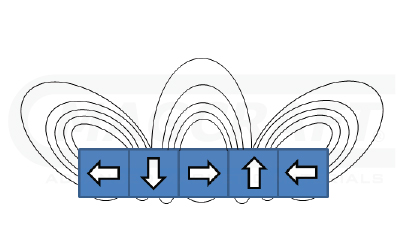A Halbach array is a specific arrangement
of a series of permanent magnets. The array has a spatially rotating pattern of
magnetism which cancels the field on one side, but boosts it on the other. The
main advantages of Halbach arrays are that they can produce strong magnetic
fields on one side whilst creating a very small stray field on the opposite
side. This effect is best understood by observing the magnetic flux
distribution.

Strips of ferromagnetic materials
(materials which can be permanently magnetized) with alternating magnetizations
are combined such that the magnetic fields align above the plane of the
composite structure, whilst below the structure the fields are in opposite
directions and cancel out. More precisely, the alternating components of
magnetization are p/2 or 90
o out of phase.

In the ideal case, shown above, this
superposition would produce a field above the plane which is twice as large as if
the structure were uniformly magnetized, and no field below the plane. However,
in reality the ideal case is never observed and a very small field is produced
on the underside. This arrangement can be continued indefinitely to produce
large arrays.
These “one-sided flux” structures were
first discovered by John C. Mallinson in 1973, who described them as “curiosities”
with the potential to improve magnetic tape recording technology. However,
their true potential wasn’t realised until the 1980s, when Berkley physicist
Klaus Halbach independently rediscovered this magnetic phenomenon and created
Halbach arrays for use in particle accelerators.Halbach produced the arrays using the ferromagnetic
material cobalt to generate strong magnetic fields for focusing and steering the
particle accelerator beams.
Halbach arrays now have many applications and are used in a range of
systems of varying complexity. One of the simplest applications of Halbach arrays
is in refrigerator magnets. In this case the one-sided flux properties are
exploited in order to boost the holding power of the magnet. Variable arrays of
magnetics rods can also be combined to create simple locking systems. If the
magnetizations of the rods are arranged so the field is maximised above the
plane and minimised below it, the flux confinement can be flipped by rotating
each rod 90
o.
A more advanced example of a Halbach array
in action is in a Maglev train track or Inductrack, where magnetic levitation
is used to support the carriage. The magnetic arrays lift the train a small
distance above the track and can support a weight of up to 50 times that of the
magnet. The operation is based on the principle of induction; as the array is
passed over the metallic track coils, the variations in the magnetic field
induces a voltage in the track. The track then creates its own magnetic field
and, similarly to when you attempt to push the two like poles of bar magnets
together, when this field aligns with the field produced by the Halbach array,
repulsion causes the train to levitate. Maglev trains do not suffer from many
of the frictional forces which slow down traditional wheeled trains and are
able to provide high speed transportation. In fact, the Japanese SCMaglev train
system, which reached 361 mph in 2003, currently holds the Guinness World
Record for the fastest rail transportation.
Halbach arrays are also used in advanced
scientific experiments such as synchrotrons and free electron lasers (FELs),
where they are known as Halbach ‘wigglers’. FELs have a very wide and highly
tunable frequency range, and are used in many applications ranging from medical
to military. A Halbach wiggler is one of the core components of a FEL, where the
array’s magnetic field is used to periodically ‘wiggle’ a beam of charged
particles (usually electrons). The wiggling effect causes a change in the
direction and therefore a change in the acceleration of the particles. This in
turn leads to emission of high intensity synchrotron radiation (photons) when
combined with an external laser source.
It is also possible to create Halbach
cylinders and rings, where the magnetic field is strong inside the ring or
cylinder but negligible outside, or vice versa depending on the arrangement of
magnets. These structures are typically used for brushless AC motors, where
traditionally stray fields can reduce torque and efficiency. However, because
Halbach cylinders are intrinsically shielded by their structure, with almost
all flux contained within the centre, they are able to avoid this problem and produce
higher torques.